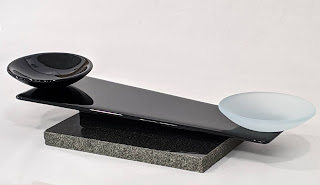More Fun with Bubbles
 |
Completed kiln-carved piece with Unique
Glass Color paints
|
I started with a simple kiln-carving with a beautiful piece of sea green transparent glass and a layer of clear. Kiln-carving is a technique using fiber paper to create a bas relief design in the glass. First I cut a piece of shelf paper large enough to accommodate the piece of glass I would be fusing (I like Spectrum's Papyros shelf paper). I then cut narrow strips of 1/8" fiber paper for the stems of my flower and oval shapes for the flowers themselves. I used white glue to secure the fiber pieces to the Papyros. The kiln-carving went into the kiln with several other pieces, and I brought it to a full-fuse. After firing, I removed the successfully carved piece from the kiln, and set it aside for several weeks (I wouldn't recommend this step!).
 |
Paint applied to the back
side of the glass
|
I finally decided the time had come to do something with my lovely kiln-carving. I removed the 1/8" fiber paper and cleaned up the piece, and then I painted UGC's Mystic Blue in the recessed area of the kiln-carving. After the paint dried, I used a wipe-out tool to clean up the edges. The UGC cleaned up easily.
Next, it was time to combine the kiln-carved piece with other glass. I decided to offset the focal piece within a frame of apple-jade, turquoise blue, and a lovely light green fusers reserve. Unfortunately, in the finished picture the fusers reserve appears white. Also, most of this beautiful glass was covered by the transparent green. It was a tough decision, but I "sacrificed" it, because it was the perfect complementary background for the kiln-carved piece. The picture below does a better job of showing the glass. (It's the dilemma of every glass artist -- to use or to save!)
 |
| Lay-up of the frame |
 |
| Into the kiln! |
The picture below shows a close-up of the raised area that resulted from the kiln-carving combined with the UGC artisan paints. I love the 3-dimensional look achieved by using the UGCs and kiln-carving!
 |
| Close-up of the finished piece |
I hope this quick tutorial gives you ideas for using this technique in your own work. I'm looking forward to doing some more experiments creating bubbles!
Happy fusing! Dana
Want to learn more? Here are a few additional resources:
All glass used was Spectrum System 96
Firing schedules omitted intentionally -- there are many good resources on-line for schedules, including Fusedglass.org

